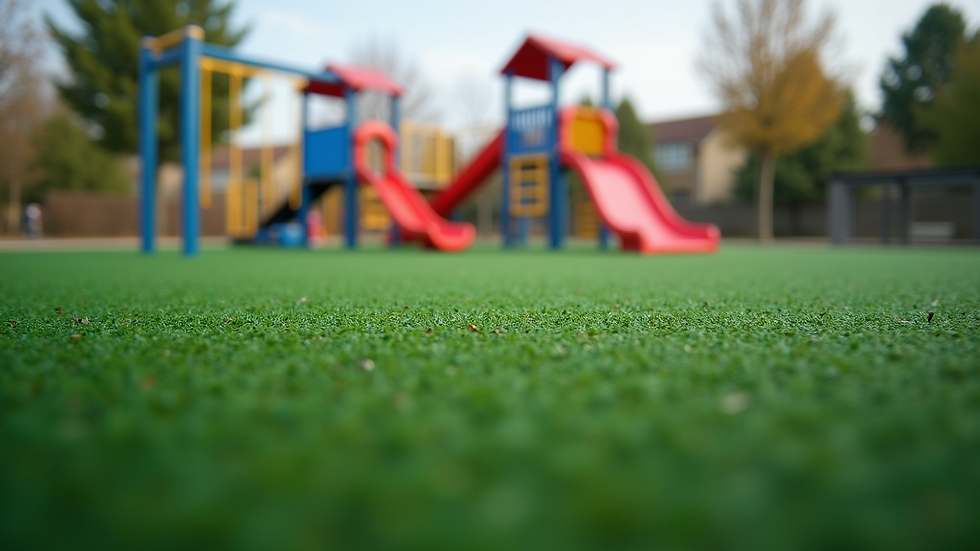How to Choose the Right Surface for a Safe Playground
- Ian Lewin
- Jul 21
- 3 min read
Creating a safe environment for children to play is crucial for their development and well-being. Choosing the right surface for a playground is one of the most important decisions in designing a safe playground. It impacts not only the safety of the children but also the overall enjoyment of the play area. In this post, we will explore various types of surfaces, their benefits and drawbacks, and how to make an informed decision for your playground.
Understanding Safe Playground Surfaces
When it comes to playground surfaces, safety is the top priority. The right surface can significantly reduce the chances of injury from falls, which are one of the leading causes of playground accidents. According to the Centers for Disease Control and Prevention (CDC), around 20,000 children visit the emergency room each year due to playground-related injuries. Investing in a safe surface can mitigate these risks.
Different materials offer varying levels of impact absorption, maintenance needs, and durability. Understanding these features can help ensure children are protected during play.

Types of Safe Playground Surfaces
There are several types of surfaces commonly used in playgrounds, and each has its unique advantages and disadvantages.
1. Wood Chips
Wood chips are one of the most popular choices for playground surfaces. They are an affordable option and provide excellent shock absorption. Additionally, they create a natural aesthetic that fits nicely into outdoor environments. However, they can degrade over time, require regular maintenance to replenish, and may harbor pests or insects.
2. Rubber Mulch
Rubber mulch is made from recycled tires and offers superior shock absorption, making it an excellent choice for playground safety. It is also long-lasting, resistant to mold and mildew, and available in various colors. On the downside, it can be costlier than wood chips and may require special installation considerations.
3. Synthetic Turf
Synthetic turf provides a clean, grass-like surface that is easy to maintain. It is durable and can withstand daily wear and tear. This surface is suitable for year-round play, but it may heat up in direct sunlight, making it potentially uncomfortable during hot weather.
4. Poured-in-Place Rubber
Poured-in-place rubber surfaces are a seamless flooring option that offers excellent safety features. They come in various thicknesses and can be customized with colors and designs to fit the playground theme. This type of surface is expensive and may require professional installation, but it provides a durable, safe playground flooring option.

What is the Cheapest Thing to Put Under a Playground?
When considering budget-friendly options, wood chips often come to mind. They are typically among the most affordable surfaces available. However, it's important to remember that the initial cost is not the only factor to consider. Long-term maintenance, safety, and durability should also be weighed when deciding.
While installing wood chips may be cheap upfront, they will need to be replenished regularly, which can add to costs over time. You might even consider alternatives like sand, which can be inexpensive but may not offer the same level of safety as other options.
Choosing the cheapest option is tempting, but it's essential to balance upfront costs with long-term safety and maintenance expenses to arrive at the best decision.
Safety Standards and Guidelines
When selecting a playground surface, it’s crucial to adhere to safety guidelines and standards set by organizations like the American Society for Testing and Materials (ASTM) and the U.S. Consumer Product Safety Commission (CPSC). These organizations provide crucial information regarding the appropriate fall heights and critical fall zones for different playground equipment.
Each type of surface also has specific impact attenuation ratings, which measure how well they absorb shock in case of falls. When evaluating your options, ensure that the selected surface meets or exceeds these safety standards. Making an informed choice based on these guidelines can prevent injuries and enhance the overall play experience.

Conclusion: Making the Best Choice for Your Playground
Selecting the right surface for a safe playground is a significant responsibility. It requires careful consideration of budget, maintenance, aesthetics, and safety standards. By understanding the various types of surfaces available and considering their advantages and disadvantages, you can create a safe environment that allows children to play freely and confidently.
Remember that while the cost is an important consideration, the primary focus should always be on the safety and well-being of the children who will enjoy the playground. Investing in quality playground flooring—such as rubber mulch or poured-in-place rubber—can provide peace of mind and years of fun for children.
Incorporating these elements into your planning process will lead to a safer, more enjoyable playground experience for everyone involved. Safe play is happy play, and ensuring a secure environment is crucial to encouraging children to be active, socialize, and explore.

.png)
.png)



Comments